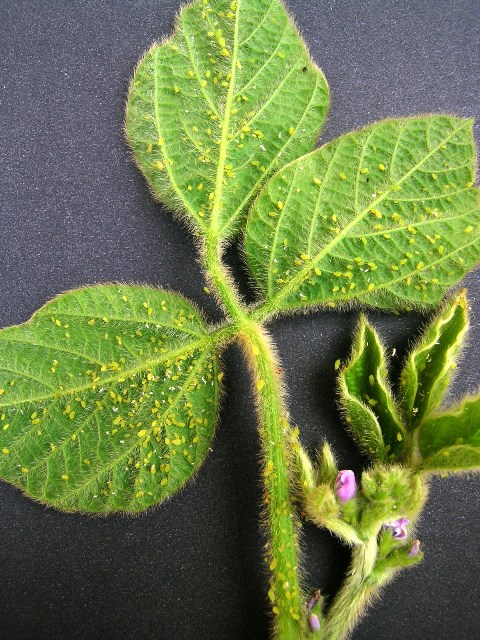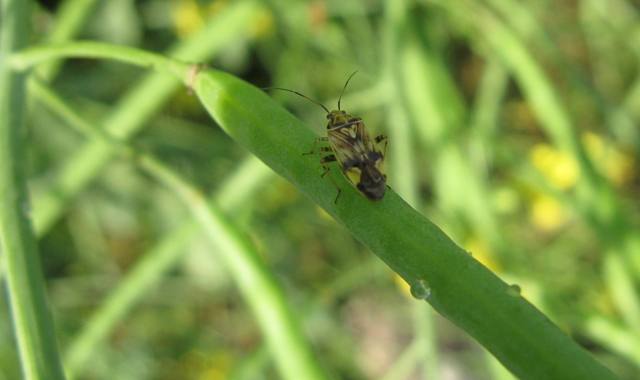Manitoba Insect & Disease Update: August 4, 2015
Summary
Plant Pathogens: Levels of fusarium head blight are being reported as low in many areas.
Increased levels of mycosphaerella are being reported in later seeded field peas in the southwest as a result of the cooler and wetter conditions. Some soybean fields are showing increasing damage due to excess moisture and subsequent root rots. Weather conditions have been conducive for white mould in edible beans, and bacterial blight has been reported in some dry beans.
Damage from sclerotinia is noted in some canola fields. Blackleg is also being noted throughtout the province, both stem lesions and basal canker. Sunflower rust is being noted in the Elm Creek area.
Insects: Lygus bugs monitoring continues in sunflowers and later-seeded canola. Scouting for soybean aphids continues; they are present in many fields but no economic populations have yet been reported.
Soybeans
Soybean aphids have been showing up in many fields, but so far populations have stayed below the economic thresholds. A few things to note regarding economic thresholds for soybean aphid:
- The economic threshold for aphids in soybeans is 250 aphids per plant, and the population is increasing, and the plants are in the R1 (beginning bloom) to R5 (beginning seed) growth stages.
- The reason that "and the population is increasing" is part of the threshold is because the actual economic injury level, where control costs will equal yield loss, is actually about 670 aphids per plant. The economic threshold, where control is suggested, has been set much lower than 670 to allow time for the spray to be applied before increasing populations could potentially reached 670 per plant. The population doubling time for soybean aphids can be as low as about 7 days if they are not being regulated well by natural enemies or weather.
- Aphid populations do not always continue to increase. So we can not assume that because a certain number is present this week that even more will be present the next week. Populations can plateau or start decreasing due to natural enemies or weather conditions or events.
- The above-mentioned economic threshold is based on the average of multiple plants selected from throughout the field and not just hotspots or field borders. Avoid making treatment decisions based on field borders. Small aphid hotspots often collapse from predation, parasitism or emigration.
- When the value of the soybean crop is high, it is a mistake to try to lower the economic threshold below 250 per plant and the population increasing. There is already a large gap between the economic injury level and the economic threshold that is suggested. But what also needs to be considered is that the damage boundary, which is the lowest insect pressure where any yield loss can be detected, is well above the 250 economic threshold that used. So it would be illogical to try to reduce a threshold which is already below a level where yield loss can not be detected. Although economic injury levels (where control cost = yield loss) do change with commodity prices, damage boundaries do not. And given that aphid populations do not increase in linear fashions, there would be no advantage, and potential costs, to spraying at levels below the suggested economic threshold for soybean aphids. The research publication where the economic thresholds for soybean aphids are presented states "setting an economic threshold at lower aphid densities increases the risk to producers by treating an aphid population that is growing too slowly to exceed the economic injury level in 7 days, eliminates generalist predators, and exposes a large portion of the soybean aphid population to selection by insecticides, which could lead to development of insecticide resistance (Journal of Economic Entomology. 2007: 1258-1267). So to summarize, monitor fields and use the suggested economic thresholds.
- When aphid levels are high, exact counts are not possible and would consume too much time. Estimates after a quick examination of the plant will be sufficient. Note in figure 1 below the soybean aphids, and the white shed skins from aphids that have molted. Avoid including the shed skins in your counts.

Figure 1. Soybean aphids and shed skins.
Canola
Crop Stage and Lygus Bugs in canola - It is the early podding stage of canola that is most sensitive to potential damage from Lygus bugs. With adequate soil moisture, plants will compensate well for loss of flowers. It is feeding directly to seeds when the seeds are young that has the highest potential to reduce yields if levels of Lygus bugs are high enough.
The economic thresholds for Lygus are actually the same as the economic injury levels, in contrast to the economic threshold for soybean aphid. So for Lygus bugs the economic thresholds can be adjusted for the value of the crop and the cost of the control. At the current value of canola and control costs the economic threshold will be in the range of 10 to 15 Lygus bugs per 10 sweeps.
Once canola has reached the R5.3 stage, where seeds in the lower pods are mottled green-brown, the seeds are mature enough that Lygus bugs are no longer considered an economic risk. There are no economic thresholds for Lygus bugs in canola at the R5.3 stage and beyond.

Figure 2. Lygus bug on canola pod.
Preharvest Interval Calculator: The Canola Council of Canada has produced a website, which can be accessed at the link below, that will assist in finding the preharvest interval of a pesticide. Recall that the preharvest interval is the number of days that must pass between the application of a pesticide and cutting of the crop (swathing or direct-combining).
Insect Monitoring Programs
Grasshopper Survey: Manitoba, Saskatchewan and Alberta have for many years surveyed grasshopper populations in August to predict the regional risk from grasshoppers the following year. The data is mapped, and this forecast is used by farmers, agronomists, and agricultural retailers to plan for the following season.
A reminder for those participating in the grasshopper survey, that counts are done during August, when the majority of grasshoppers are in the adult stage. Agronomists and farmers who would also be interested in estimating grasshopper numbers in the fields they are in and have this information included in the survey are encouraged to see the survey protocol for more details of the survey and where to send data. Estimates of grasshopper levels can be collected during regular farm visits.
A reminder for those participating in the grasshopper survey, that counts are done during August, when the majority of grasshoppers are in the adult stage. Agronomists and farmers who would also be interested in estimating grasshopper numbers in the fields they are in and have this information included in the survey are encouraged to see the survey protocol for more details of the survey and where to send data. Estimates of grasshopper levels can be collected during regular farm visits.
"Estimates" of grasshopper populations is stressed as it will not be possible to accurately count grasshoppers along a field edge or ditch area as they will be moving around as you get near the area of the count. But estimate of what is present gives us some idea of the relative numbers that are present in different areas.
Data from the survey, along with weather data during the egg laying period of the grasshoppers, is used to produce a forecast map for 2016.
The protocol and data sheet for the grasshopper survey is at: http://www.gov.mb.ca/agriculture/crops/insects/mb-grasshopper-survey.html
Compiled by:
John Gavloski, Entomologist
Manitoba Agriculture, Food and Rural Development
Phone: (204) 745-5668 Fax: (204) 745-5690.
To report observations on insects or plant pathogens that may be of interest or importance to farmers and agronomists in Manitoba, please send messages to the above contact address.
To be placed on an E-mail list so you will be notified immediately when new Manitoba Insect and Disease Updates are posted, please contact John Gavloski at the address or numbers listed above.
Manitoba Insect & Disease Update: August 4, 2015
John Gavloski, Entomologist
Manitoba Agriculture, Food and Rural Development
Phone: (204) 745-5668 Fax: (204) 745-5690.
To report observations on insects or plant pathogens that may be of interest or importance to farmers and agronomists in Manitoba, please send messages to the above contact address.
To be placed on an E-mail list so you will be notified immediately when new Manitoba Insect and Disease Updates are posted, please contact John Gavloski at the address or numbers listed above.
Manitoba Insect & Disease Update: August 4, 2015
